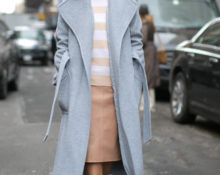
Knitted coats are gaining popularity in Russian regions. This is a beautiful, fashionable, and most importantly – an extremely warm item of clothing. Crocheted coats can be worn in spring and summer, and the most insulated ones can be worn in autumn. The main difference between summer coats is that they are more decorative and openwork, and also quite cool.
The advantages of crocheting any item are that the craftswoman has a chance to show her skills to many people and show off the knitted item. In addition, things sewn or knitted by hand will fit your figure. In addition, such things are exclusive, you can be sure that no one else wears such coats except you.
Light coat
While for autumn and spring coats are chosen to be warmer and more comfortable, for summer you can create something much more beautiful and less practical. A decorative coat will help demonstrate the aesthetic taste of its owner, as well as her impeccable knitting skills.A lightweight coat with openwork swirls and a translucent border goes perfectly with loose summer dresses, sundresses and classic jeans. This coat is knitted easily and simply.
By the way, no one is stopping the needlewoman from using a wide variety of yarn to make more original things. Free experiments with threads can lead to interesting, and most importantly, pretty results. The knitting process can be diversified with new original techniques, unusual textures and colors of threads. This will help not only improve your knitting skills, as well as find your own style, but also sooner or later knit a truly unique, beautiful and worthy thing. Even from primitive patterns you can knit an interesting coat if you use original yarn, for example, fluffy threads, leather threads, gradient threads.
Knitting process

All coats must be knitted in one single piece. It will immediately include the dorsal part, the right and left parts.
First we knit a simple chain. Then we form several basic chains. Next we do a lift from the hook and sixty-five rapports. It is necessary to knit a kind of arch and connect everything inside it with a single chain. This way you will get a solid image of openwork patterns. Next, the row needs to be completed; to do this, you need to move some distance from the chain.
Then, from the third row, it is necessary to knit the fabric forward and backward, in alternating directions.
From the fiftieth row we begin to divide the fabric into several parts to knit openwork patterns. Sixteen rapports are knitted on the right and left sides. Thirty-three - on the back. Up to the sixty-seventh row you also need to knit according to the direct and reverse principle.
From the sixty-fifth row it is necessary to carefully design the neck part.
Then the sleeves are knitted. The thread is connected to the bottom border.
Next, classic knitting continues according to the same principle.
From the twentieth row of sleeves, knitting begins in columns; it is necessary to form thirty-two pieces. Finish the knitting with the usual connecting column.
Then an openwork border is tied to the sleeves.
At the very end, the final coat is assembled from several connected parts. To begin with, a stand-up collar is attached - sewn in four rows to the main panel. Then the right and left parts are trimmed with a border using columns. Next, the border of the collar and the border of the right and left parts are tied - it is necessary to knit two rows of columns. If desired, the final coat can be decorated with buttons. Summer coat is ready!


 0
0





